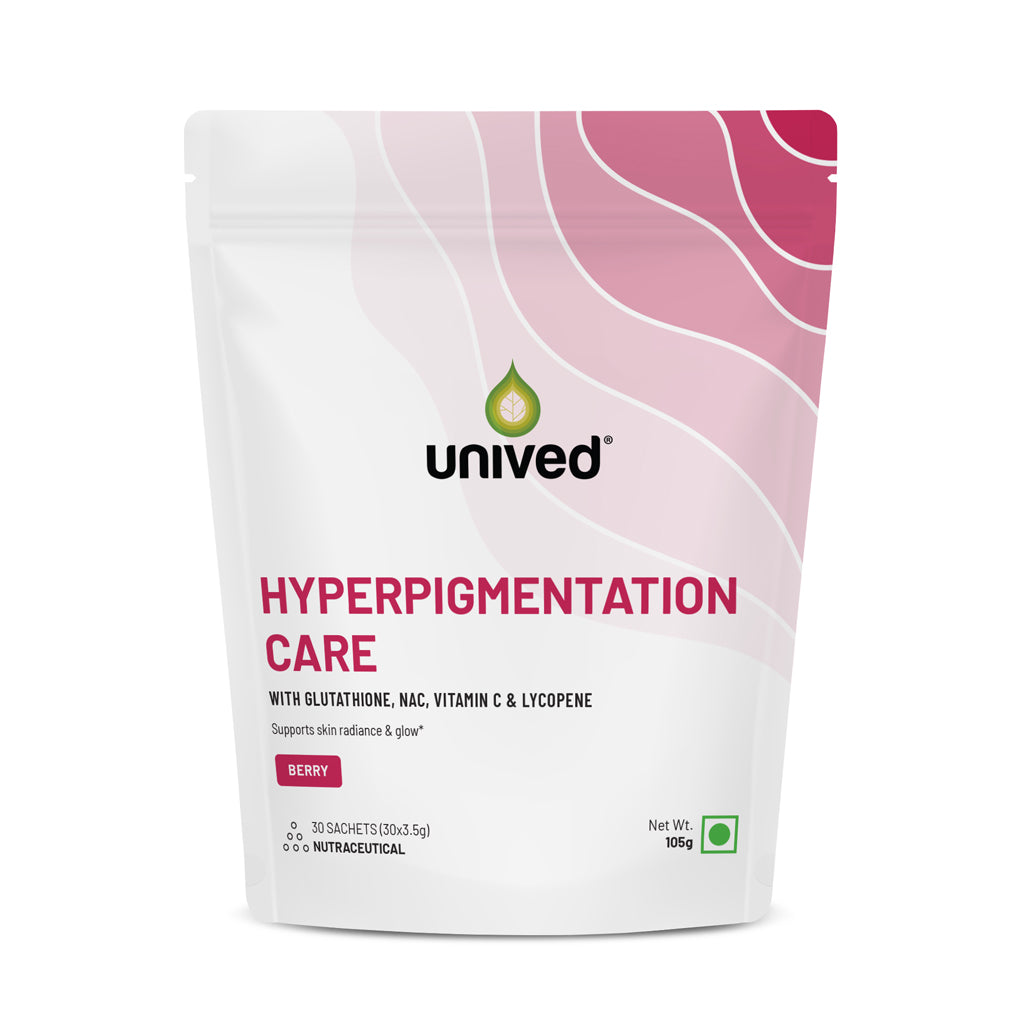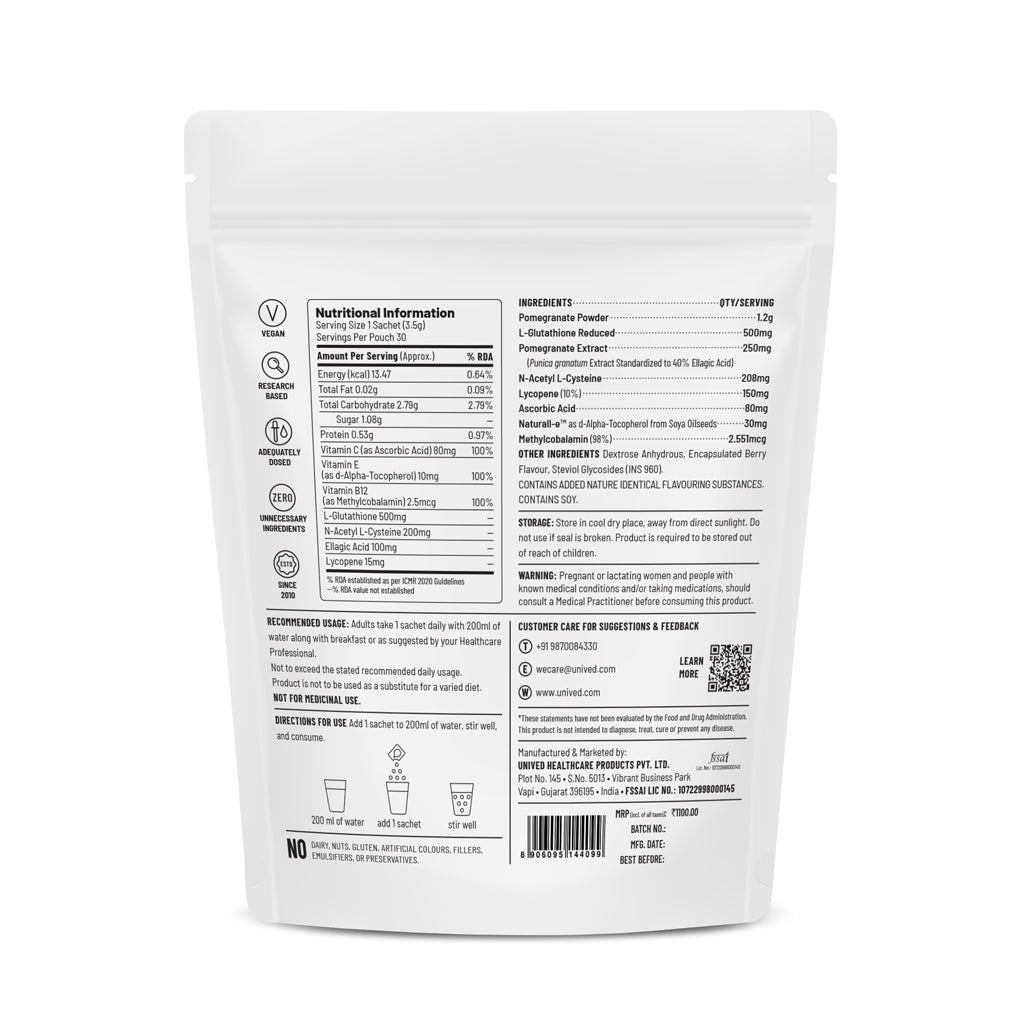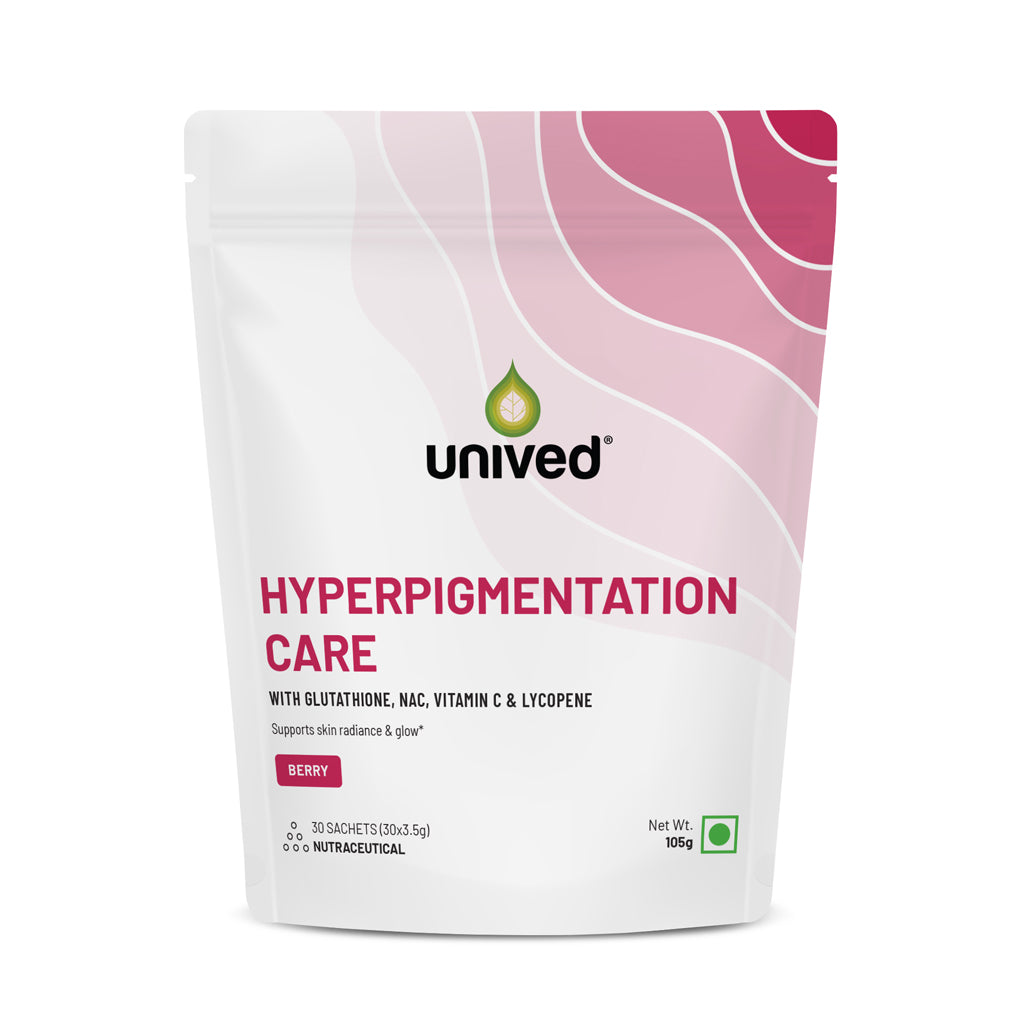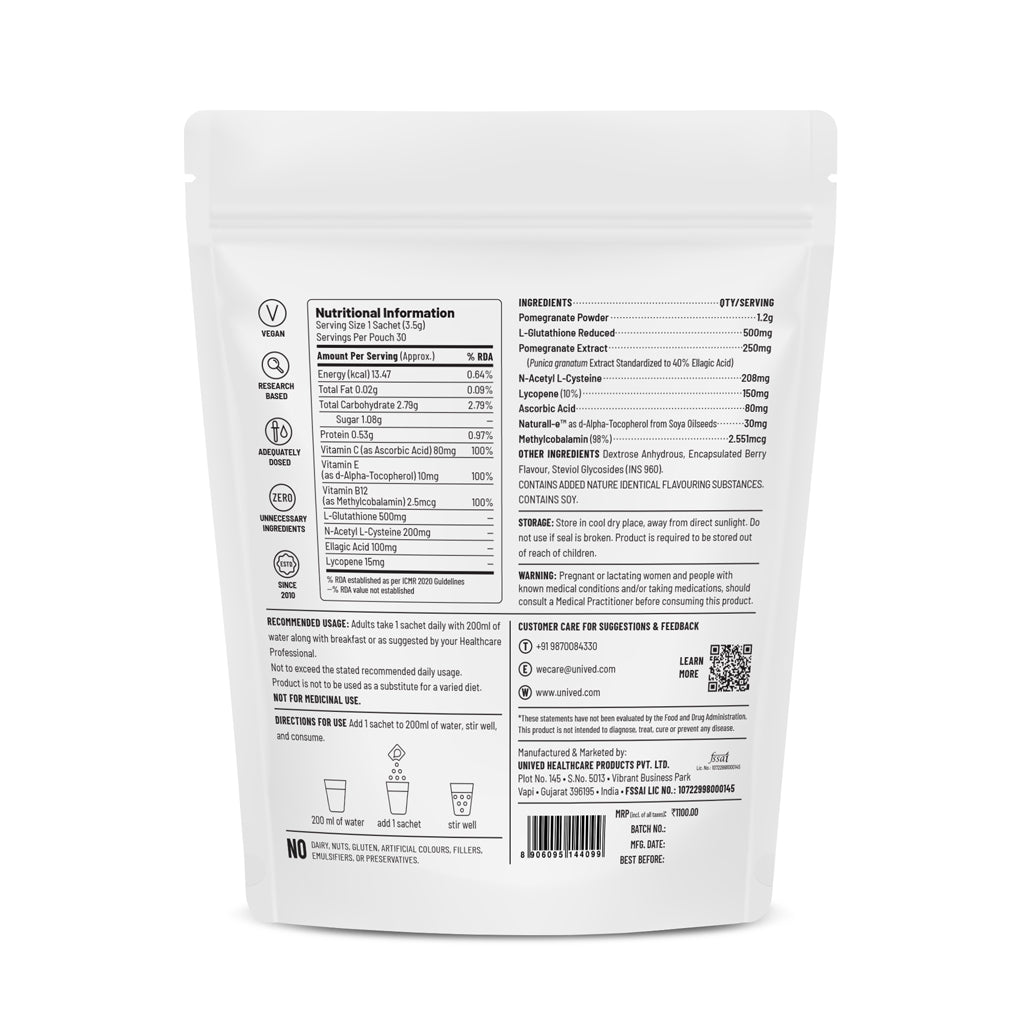Skin Health
Hyperpigmentation Care
Hyperpigmentation Care
Couldn't load pickup availability
Key Benefits
- Regulates melanin synthesis.
- Provides antioxidant support & protects the skin from harmful UV radiation.
- Helps reduce dark spots, age spots & hyperpigmentation.
- Helps reduce wrinkles and increase elasticity.
- Improves hyperpigmentation & discolouration while brightening the skin.
- Effective for acne-induced hyperpigmentation, sun damage, melasma, age spots, and other skin blemishes.
- Suitable for all genders.
- Helps to lighten hyperpigmentation & dark spots.
- Protects the cells from free radical damage.
- Improves skin elasticity and reduces wrinkles.
- Effective in reversing problems like age spots, melasma and post-inflammatory hyperpigmentation
- Contains antioxidants which helps to reduce UV-induced inflammation & hyperpigmentation.
- Helps protect the skin from photo-induced skin problems.
- Contains glutathione in its active form.
- Helps to increase collagen production.
Batch Details
Serving Size & Servings Per Container
Suggested Use
- Learn More
- Ingredients
- FAQ
Melanin, the pigment responsible for skin and hair color, is
produced by melanocytes beneath the skin. The amino acid L-Tyrosine acts as a
precursor for melanin synthesis through enzymatic reactions (Raper Mason
pathway). Melanin comes in two forms: darker Eumelanin (black and brown) and
lighter Pheomelanin (yellow-red). Controlling L-Tyrosine and L-DOPA levels is
important for regulating melanin production (1).
In the presence of oxygen, the tyrosinase enzyme converts
tyrosine into DOPA and then into DOPA-quinone. The presence or absence of
cysteine determines whether the pathway leads to eumelanin (darker pigment) or
pheomelanin (lighter pigment). Different skin types have variations in how
melanosomes (where melanin is stored) degrade during keratinocyte
differentiation, resulting in diverse skin colors and complexions. Disruptions
in the melanin production process, caused by internal and external factors, can
lead to hyperpigmentation disorders (1, 2).
Hyperpigmentation refers to various skin disorders
characterized by dark patches or discoloration. Examples include melasma,
post-inflammatory hyperpigmentation, and solar lentigines (sun and age spots).
Melasma specifically presents as brown patches on the skin, often becoming more
noticeable after sun exposure.
Multiple factors contribute to the development of
hyperpigmentation. These include genetics, hormonal imbalances, pregnancy,
exposure to UV radiation, stress, hormone therapy, certain medications, and
cosmetics. Among these, genetic predisposition and sun exposure play crucial
roles.
Melasma involves increased melanin deposition, presenting as
brown patches on the face. It commonly affects women of childbearing age, with
an onset between 30-55 years (1, 2).
Our Formulation
The potential targets for the depigmenting and
hyperpigmentation control agents include inhibitors of melanocyte stimulation,
tyrosinase enzyme inhibitors, inhibitors of melanosome transfer, and degraders
of formed melanin in keratinocytes. The widely targeted approach includes the
inhibition of tyrosinase, most important rate-limiting enzyme of the
melanogenesis pathway (1).
Role of each ingredient:
Glutathione:
Glutathione, a powerful antioxidant found within cells,
plays a vital role in many physiological functions and now is getting
recognized as a skin-lightening agent. It reduces hyperpigmentation by
inhibiting the tyrosinase enzyme, blocking its activity, and interfering with
melanin synthesis. It promotes phaeomelanin synthesis. Additionally,
glutathione's antioxidant properties scavenge free radicals and protect against
UV-induced damage. It also offers benefits such as wrinkle reduction, improved
skin brightness, and anti-aging effects (2).
N-Acetyl L-Cysteine (NAC) :
Glutathione (GSH) is not easily absorbed when taken orally
due to the action of an intestinal enzyme called γ-glutamyl transpeptidase
(GGT). To increase GSH levels, a strategy is to use N-acetylcysteine (NAC), a
precursor to cysteine. Cysteine is essential for GSH synthesis. Studies have
shown that NAC is well absorbed by the intestine and supplementation with NAC
effectively raises GSH levels (3, 4).
ELLAGIC ACID:
Ellagic acid has both anti-fibrosis and antioxidant
properties. It works by inhibiting the production of melanin, which is
responsible for skin pigmentation, through its effect on an important enzyme
called tyrosinase. When ellagic acid is taken orally, it has been found to have
a skin-lightening effect on mild sunburn. In an animal study, ellagic acid was
administered orally and showed a dose-dependent effect in reducing the number
of melanocytes in the skin's outer layer. Furthermore, when humans were given
orally administered pomegranate extract rich in ellagic acid, it demonstrated a
protective effect against mild sunburn caused by exposure to UV radiation (5).
VITAMIN C:
Vitamin C, a powerful antioxidant, plays a crucial role in
collagen synthesis, offers photoprotection, reduces melanin production, acts as
a free radical scavenger, and modulates the immune system. By interacting with
copper ions at the active site of tyrosinase, vitamin C inhibits its action,
resulting in reduced melanin formation. Additionally, vitamin C aids in the
regeneration of glutathione, converting oxidized glutathione back into its
active form (6, 7, 8).
VITAMIN B12:
People with severe hyperpigmentation in different areas of
their skin often suffer from Vitamin B12 deficiency. It is hypothesized that
Vitamin B12 deficiency affects melanin synthesis and transfer of melanin
between melanocytes and keratinocytes, resulting in hyperpigmentation (9).
Vitamin E:
Vitamin C works synergistically with vitamin E to protect
the skin from oxidative damage. It plays an important role in photoprotection
& also inhibits UV-induced free radical damage to the skin. By working
together, vitamins C and E provide enhanced antioxidant protection and help
maintain the health and integrity of the skin (10).
Lycopene:
Lycopene, a natural antioxidant, has been extensively
studied for its ability to protect against ultraviolet radiation (UVR) and
effectively scavenge reactive oxygen species (ROS). It has shown promise in
reducing skin redness, improving skin appearance and pigmentation, and
mitigating damage and aging caused by sunlight exposure. Lycopene-rich products
can serve as internal sun protection and may have the potential as a
nutraceutical for sun protection (11).
References:
1. Nautiyal,
A., & Wairkar, S. (2021). Management of hyperpigmentation: Current
treatments and emerging therapies. Pigment cell & melanoma research, 34(6),
1000-1014.
2. Sonthalia,
S., Daulatabad, D., & Sarkar, R. (2016). Glutathione as a skin whitening
agent: facts, myths, evidence and controversies. Indian journal of dermatology,
venereology and leprology, 82(3).
3. Schmitt,
B., Vicenzi, M., Garrel, C., & Denis, F. M. (2015). Effects of
N-acetylcysteine, oral glutathione (GSH) and a novel sublingual form of GSH on
oxidative stress markers: A comparative crossover study. Redox Biology, 6,
198-205.
4. Janeczek,
M., Moy, L., Riopelle, A., Vetter, O., Reserva, J., Tung, R., & Swan, J.
(2019). The potential uses of N-acetylcysteine in dermatology: a review. The
Journal of Clinical and Aesthetic Dermatology, 12(5), 20.
5. Kasai,
K., Yoshimura, M., Koga, T., Arii, M., & Kawasaki, S. (2006). Effects of
oral administration of ellagic acid-rich pomegranate extract on
ultraviolet-induced pigmentation in the human skin. Journal of nutritional
science and vitaminology, 52(5), 383-388.
6. Sanadi,
R. M., & Deshmukh, R. S. (2020). The effect of Vitamin C on melanin
pigmentation–A systematic review. Journal of Oral and Maxillofacial Pathology:
JOMFP, 24(2), 374.
7. Pullar,
J. M., Carr, A. C., & Vissers, M. C. (2017). The roles of vitamin C in skin
health. Nutrients, 9(8), 866.
8. Sitohang,
I. B. S., Anwar, A. I., Jusuf, N. K., Arimuko, A., Norawati, L., &
Veronica, S. (2021). Evaluating Oral Glutathione Plus Ascorbic Acid,
Alpha-lipoic Acid, and Zinc Aspartate as a Skin-lightening Agent: An Indonesian
Multicenter, Randomized, Controlled Trial. The Journal of Clinical and
Aesthetic Dermatology, 14(7), E53.
9. Agrawala,
R. K., Sahoo, S. K., Choudhury, A. K., Mohanty, B. K., & Baliarsinha, A. K.
(2013). Pigmentation in vitamin B12 deficiency masquerading Addison’s
pigmentation: A rare presentation. Indian Journal of Endocrinology and
Metabolism, 17(Suppl1), S254.
10. Pullar, J.
M., Carr, A. C., & Vissers, M. C. (2017). The roles of vitamin C in skin
health. Nutrients, 9(8), 866.
11. Zhang, X.,
Zhou, Q., Qi, Y., Chen, X., Deng, J., Zhang, Y., Li, R., & Fan, J. (2023).
The effect of tomato and lycopene on clinical characteristics and molecular
markers of UV-induced skin deterioration: A systematic review and meta-analysis
of intervention trials. Critical reviews in food science and nutrition, 1–20.
- Pomegranate Powder: 1.2g
- L-Glutathione Reduced: 500mg
- Pomegranate Extract (Standardized to 40% Ellagic Acid): 250mg
- N-Acetyl L-Cysteine: 208mg
- Lycopene (10%): 150mg
- Ascorbic Acid: 80mg
- Naturall-e™ (d-Alpha-Tocopherol from Soya Oilseeds): 30mg
- Methylcobalamin (Vitamin B12): 2.551mcg
- OTHER INGREDIENT: Dextrose Anhydrous, Encapsulated Berry Flavour, Steviol Glycosides (INS 960)
How long does it take to see results?
You have to take the supplements daily for at least 3 months to see visible results.
Is it necessary to take it on an empty stomach?
We recommend taking it on an empty stomach for better absorption of glutathione. But if you are not comfortable taking it on an empty stomach then you can take it after a light breakfast.
Along with taking the supplement, what else can I do to get results?
In addition to taking the supplement, it is recommended to incorporate fruits and vegetables into your diet, minimize sun exposure, and use sunscreen when outdoors.
Is this product suitable for pregnant/lactating women?
We will advise you to consult with your doctor before taking any supplements.
How long is it recommended to consume this product?
It is recommended to consume this product for a period of 3-6 months to see visible results. After that, the decision to continue is entirely up to you.
Is it a skin-whitening supplement?
No, it is not a skin-whitening supplement.




